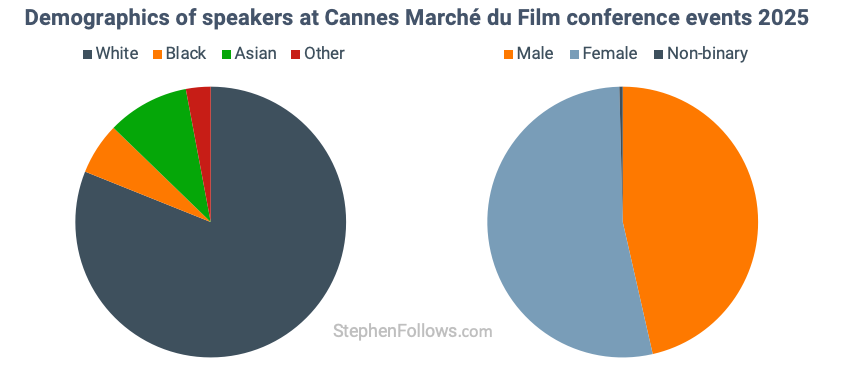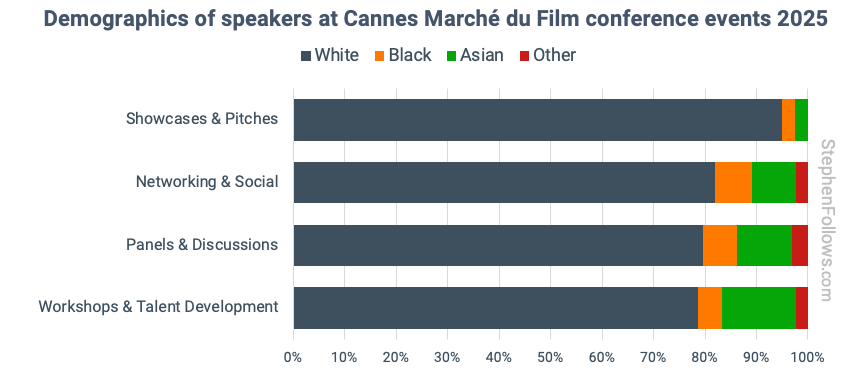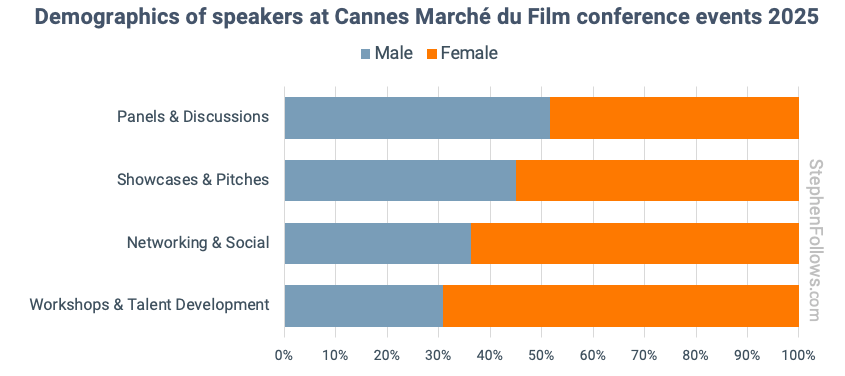Eight takeaways from the 2025 Cannes Marché du Film
Under the surface of a cautious Cannes lay a more important story. This may have been the year the Marché began to redefine its role.
Cannes 2025 was not a washout. The Croisette was crowded, the sun came out, and over 15,000 industry professionals turned up.
But something has shifted.
I believe that we will look back at 2025 as an inflection point. The most negative reading might be that this was the year that Wylie Coyote realised there was no ground underfoot. A more positive reading might just be that it’s another bend in the wobbly journey of the evolution of the film industry.
The usual frenzy of handshakes, hype and headlines gave way to a slower, flatter market. Deals happened, screenings rolled, and the rosé flowed, but the energy was cautious and the big swings were few.
If last year’s Marché was about bouncing back, this year felt more like bracing for what comes next.
The mood across the market was one of quiet calculation. Sellers came armed with high-profile packages, but many buyers were wary, sitting on their hands unless the film came with a proven name, a festival slot, or a clear global angle. Conversations revolved around political risk, production costs, and the hard maths of international distribution. Everyone had something to show, but fewer people were buying, and even fewer were betting big.
And yet, amid the uncertainty, the market is clearly evolving. Cannes is trying to stay relevant, to reframe what the Marché is for and evolve how it delivers value.
Here are eight trends I spotted:
Cannes felt quieter and flatter this year. Cannes 2025 lacked its usual buzz, with a subdued atmosphere and restrained energy throughout the Marché.
Everyone is playing it safe with their money. Buyers and sellers were cautious, avoiding risk and focusing only on projects with proven commercial appeal.
The middle tier of films is being squeezed out. Mid-budget, non-star-driven films struggled to attract buyers in a market focused on extremes.
Microsoft vanished, but the AI conversation stayed. AI remained a major theme despite Microsoft's absence, with growing focus on ethical, legal and creative concerns.
Cannes is turning into a conference as much as a market. The Marché featured more panels and talks, reflecting a shift towards thought leadership alongside deal-making.
Poster design is finally catching up. Sales artwork quality improved significantly, signalling a more professional and visually strategic approach to marketing.
The market space is changing to make room for seating not sales. Informal seating areas replaced some booths, reflecting changing behaviours and networking styles.
Sustainability is still a brand, not a behaviour. Despite green messaging, Cannes practices remained resource-heavy, revealing a gap between values and actions.
Let’s go through each in turn.
1. Cannes felt quieter and flatter this year
Across the board, professionals commented on how subdued the market felt this year. There was no single high point, no day when everything seemed to come alive.
This was partly structural as the Marché started on a Tuesday, breaking with its usual rhythm and thinning out the natural build-up of energy. But it was more than just the calendar. The buzz that usually defines Cannes felt muted, replaced by a steadier, more restrained tempo that never quite spiked.
Despite a reported 15,000 attendees and a packed programme of screenings and talks, the atmosphere inside the Palais and around the pavilions was noticeably less intense.
For many, the week felt more like a collection of parallel meetings than a unified market. Some sales agents described buyers as “very focused” and “engaged,” but only around very specific projects. Most others felt that the pace was slower and the stakes were lower.
This lack of urgency may point to a more profound shift. Cannes is no longer guaranteed to be the epicentre of deal-making. With digital tools, year-round access to buyers, and growing regional markets, Cannes must now prove its value each year.
2. Everyone is playing it safe with their money
Risk aversion was the defining financial mood of this year’s Marché. Buyers were highly selective, sellers were under pressure, and nobody wanted to be the one caught overpaying in a volatile market.
The main trigger was political: Donald Trump’s proposal of a 100% tariff on foreign-produced films sent a wave of uncertainty through the Croisette. While many dismissed it as posturing, it immediately clouded negotiations, especially for projects relying on North American pre-sales.
This sense of caution filtered through every level of the market. Streamers were present but subdued, favouring global rights on big, recognisable titles over speculative buys. U.S. distributors were particularly hesitant, forcing international sellers to adjust expectations downward.
Some buyers openly stated they were holding back to see where the major players landed before making offers. Even those still active were operating with “tighter filters,” carefully weighing commercial viability, star power and genre before committing.
The result was a fragmented market, where a few packages generated competitive bidding, but much of the inventory sat idle. Films without A-list attachments or strong festival credentials struggled to move.
3. The middle tier of films is being squeezed out
One of the most apparent structural shifts at Cannes 2025 was the near disappearance of the market’s middle ground. Films that would have comfortably sold five or ten years ago, such as modestly budgeted dramas or festival-friendly titles without big stars, are now struggling to find homes. This middle tier has long been the backbone of the independent sector but is increasingly being edged out by a market that only rewards the extremes.
At the top end, there was no shortage of money for star-driven or award-contending packages. Mubi’s reported $24 million multi-territory deal for Die My Love set the tone early. The project had all the right ingredients, with Jennifer Lawrence, Robert Pattinson, and a director with a Cannes pedigree.
Everything else, especially films without marquee talent, faced an uphill battle. Sales agents described a growing reluctance among buyers even to consider projects that lacked clear marketing hooks or theatrical potential.
Films that might once have been seen as safe bets are now viewed as liabilities. They are squeezed between rising production costs and shrinking downstream revenues. The message from buyers was clear: If your film cannot stand out at a glance, it might not stand a chance.
4. Microsoft vanished, but the AI conversation stayed
Last year, Microsoft was a key sponsor of the AI Pavilion at Cannes. This year, they were nowhere to be seen.
(While it may not make corporate sense to promote technology to filmmakers, 2025 saw the return of ever-present stimulants sponsors, hawking caffeine, alcohol and sugar).
Microsoft’s decision not to return was noticeable, mainly because artificial intelligence remained one of the most talked-about themes across panels, tech showcases, and side events. The withdrawal of one of tech’s most prominent players suggests that the corporate push behind AI in film may be entering a new phase. It now feels less about visibility and more about caution.
Even without Microsoft, the Marché leaned heavily into technology. The newly launched Village Innovation covered one thousand square metres and featured tools ranging from AI script analysis to virtual production stages.
But alongside the excitement came concern. Many panels struck a cautionary tone, highlighting unresolved questions around copyright, labour rights and creative control.
Some speakers warned against using AI to mimic the styles of known directors. Others called for clear ethical guidelines and legislative safeguards. AI in film has grown from an ignorable novelty to a real, scary legal, artistic and industrial challenge.
5. Cannes is turning into a conference as much as a market
This year’s Marché featured a noticeable shift in programming. Alongside the usual meetings and screenings, there was a marked increase in the number of live panels, talks and curated public events.
A cynic might conclude that this was a deliberate effort to give attendees another reason to buy a €439-€600 Marché pass rather than conduct their business on the other side of the security barrier (read: Caffe Roma).
But also it reinforces the notion that the Marché is a space for thought leadership and strategic conversation, not just transactions. In practice, it means more people sitting in rooms listening to peers, and fewer hours on the floor chasing sales.
And it is working. Many of the talks were packed, with strong line-ups and genuinely engaged audiences. Panels covered everything from international co-production to AI ethics and sustainability. They featured high-profile names and plenty of substance.
However, while the number and quality of sessions have grown, I researched who the speakers were and found that the platform still belongs to a narrow group. Across all Cannes conference events in 2025, around 85% of speakers were white, and male voices still dominated the majority of events.
Gender representation is improving, with women making up nearly half of panel participants, but racial diversity lags far behind.
In addition, men are more likely to showcase work than participate in “talent development”, with the inverse being the case for women.
6. Poster design is finally catching up
One of the more surprising shifts at Cannes this year was the noticeable improvement in poster design. For years, the Marché has been known for its comically poor sales artwork.
Keep reading with a 7-day free trial
Subscribe to StephenFollows.com - Using data to explain the film industry to keep reading this post and get 7 days of free access to the full post archives.











